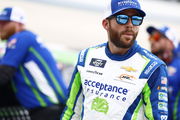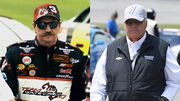

Speed thrills but kills. Racing at up to 200 miles per hour, NASCAR drivers experience a personal tryst with near-death situations. However, some NASCAR race tracks have earned an infamous reputation for being too dangerous to race on. Leading the list among them is ‘The Track That Ate the Heroes’, Langhorne Speedway.
Watch What’s Trending Now!
The Langhorne Speedway was established in 1926, and in its lifetime, it hosted numerous stock-car, open-wheel, and motorcycle races. The eastern Pennsylvanian short track witnessed 27 deaths, including 18 drivers, and countless injuries, which have haunted drivers forever. Even motorsports Hall of Famer Bobby Unser described the speedway, saying, “That was the most dangerous track on Earth.”
ADVERTISEMENT
A dark history of the Langhorne Speedway
Langhorne Speedway’s inauguration was initially set to be held on May 31, 1926. However, following inclement weather, the event had to be postponed to June 12. The National Motor Racing Association had built the one-mile dirt track to originally host 100-lap races. Until 1930, these short races continued on the dirt track.
With time, track officials faced several problems, including preparation of the surface, disagreements with the management, and most importantly, a poor attendance record. That is when Pappy Hankinson took over the ownership of Langhorne Speedway and breathed life into it. Hankinson proposed hosting stock car races on the track, and the idea took flight for the first time in 1940.
Roy Hall from Atlanta, Georgia, won the first-ever 200-lap stock-car race at the Langhorne Speedway. The craze for stock car racing continued before World War 2 disrupted its progress. Just like every other American race track, Langhorne was shut down until 1946. However, that was not the end of the problems for the infamous racetrack, as Hankinson passed away mere weeks after the government’s ban on motorsport was lifted in 1942.
ADVERTISEMENT
But by the time of his passing, Hankinson had introduced sprint car racing to the race track successfully, and stars had already been invited to race. But soon, dark times would follow.
ADVERTISEMENT
April 7, 1963, was one of the darkest days in the history of American motorsport. During the second of two 50-lap USAC sprint car races at Langhorne Speedway, a tragic incident unfolded when Bobby Marvin, driving the Wergland’s Chevy, collided head-on into the outside rail and rolled onto a barrage of other cars in the race. A T-bone wreck followed, and a blazing fire engulfed Marvin’s car, ultimately leading to his death at the hospital two hours later.
ADVERTISEMENT
Mario Andretti, who was one of the competitors in the race, could do nothing but watch in horror as he recalled, “When he flipped, the car landed on its wheels, but it was on fire, and he burned to death.”
Apart from Marvin, 17 other race car drivers lost their lives at the unforgiving Langhorne Speedway. IndyCar legend Jimmy Bryan was fatally injured in the first lap of the 1960 National Championship race and passed away soon after. Bryan was considered as one of the best drivers to ever grace Indy Car racing. In 1952, Cup Series racing faced its first casualty when Larry Mann died owing to fatal injuries he suffered at Langhorne. While everyone would want the death tally to end here, sadly, the list went on.
The track also claimed the lives of five motorcycle racers, a flag man, and three spectators. The statistics underline Langhorne Speedway’s reputation as the most dangerous motorsport track ever. The recurrent pattern of fatalities and injuries forced race track experts to examine it, and soon, it was considered an irredeemable track to race on.
ADVERTISEMENT
Read More: The Dark History Behind NASCAR’s Forgotten Racetrack- Raleigh Speedway
Top Stories
Ross Chastain Labels NASCAR Driver “The Most Punchable Face” to Excuse Himself Over Punchgate Controversy

Jimmie Johnson Poaches Richard Childress’ Key Ally Ahead of NASCAR 2026 Season

When Rick Hendrick Walked Away From $1,000 to Avoid Dale Earnhardt Sr’s Wrath

NASCAR’s Next Big Villain Named as Denny Hamlin Enters Fans’ Good Books

Commissioner Steve Phelps Quits NASCAR Days After Getting Exposed in Lawsuit Trial

The dusk of Langhorne was imminent
The late 1950s saw a great number of racers losing their lives at the Langhorne Speedway. This forced the administration to take action and investigate the reason for the speedway’s violent reciprocation towards drivers.
ADVERTISEMENT
Officials called in Indianapolis Motor Speedway superintendent Clarence Cagle, who was known far and wide for being a speedway surface and design expert. Clarence and his team poured concrete footers and laid a concrete table across the track around 10 feet in, and covered the new foundation back with dirt. As he allowed it to settle in the winter, Cagle expected to solve some problems.
However, as the odd occurrences continued with racer Johnny Boyd escaping a near-death accident next June, Cagle was called back to check on the track. Upon a re-examination, the expert couldn’t find any signs of concrete despite digging 25 feet into the ground. Terrifyingly, the swampland on which Langhorne Speedway was built, swallowed the concrete whole.
As time passed, housing and commercial sites surrounded the speedway. Eventually, the urbanization spread to the race track, and it was deemed too valuable for motorsports. Neighbors started complaining about the unwanted noise levels, and the track managed to host events until 1971. In 1971, the track was closed down forever, and with it, a memoir of some dark memories.
ADVERTISEMENT
Watch This Story: Dale Earnhardt Jr taken aback by 33-year-old barn find that once propelled him to victory lane
ADVERTISEMENT
ADVERTISEMENT
ADVERTISEMENT

